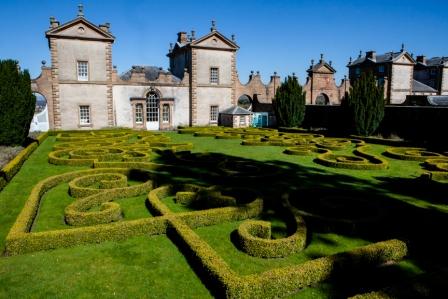The Forest Kings and Queens of Chatelherault
As work continues to remove 20 hectares of non-native woodland from the High Parks of Chatelherault, an ancient Iron Age, Roman and Early Medieval landscape is being rediscovered by volunteer archaeologists.

The clearance of mid-20th century conifer plantations is revealing previously unknown or unrecorded archaeological sites which are currently being researched by CAVLP Heritage volunteers. These discoveries will offer an insight into how the earliest inhabitants of Hamilton lived in, and shaped the ancient woodlands of Chatelherault Country Park, now part of the Clyde Valley National Nature Reserve (NNR).
Chatelherault’s own ‘Time Team,’ are stepping forward from the Bronze age discoveries of the 1930’s into the Iron Age, Roman and Early Medieval times, spanning a gap of 2000 years from approximately 1000 BC to 1000 AD.
It is thought that the later medieval royal hunting forest of Cadzow has origins as a seat of power for the early Kings of Strathclyde who ruled the area through the Roman period until the 11th century, when Strathclyde ceased to be an independent kingdom. Current research will look for proof that Chatelherault has a history that started with our Iron Age ancestors and lasted until the last Kings of Strathclyde.
Managed by Northlight Heritage and supported by South Lanarkshire Council, Heritage Lottery Fund supported Clyde and Avon Valley Landscape Partnership (CAVLP) and Historic Environment Scotland, the work comes hot on the heels of the recent discovery of what could be the ancient settlement of Cadzow, during M74 construction work.
The contemporary discoveries come 70 years later than nationally important finds made by amateur archaeologist Ludovic Mann at Chatelherault in the 1930s. He discovered a Bronze Age cemetery which was widely reported at the time in the Hamilton Advertiser, Glasgow Herald and the Scotsman newspapers.
The most unusual objects unearthed in 1939, were a large, elaborately decorated stone slab grave containing the skeleton of a young woman and a cremation urn which had remained undiscovered in their forest resting place for over 3000 years.
Items found in other burials were everyday items and possessions of the people of Cadzow’s forest that give us an insight into their daily lives. One object was an archer’s bracer – a wrist guard carved from polished stone – that protected forest hunters from the whip of the bow string when firing an arrow. A burial cist can still be seen in the Settlement Gallery in Hamilton Low Parks Museum. If you want to know what it was like to be a Bronze Age hunter – South Lanarkshire Leisure and Culture Trust have a modern day archery range close to the spot where the finds were made all those years ago, which is available for private bookings.
CAVLP Heritage volunteers are also investigating the earliest place-names of the area through the project ‘Mapping the Past.’ Until the 12th century, the language spoken in this part of Scotland was Cumbric, which was very similar to Old Welsh, and place-names familiar to us today, such as ‘Lanark,’ are actually of old Welsh origin. The original name for Hamilton was ‘Cadzow’ or ‘Cadihou,’ and volunteers are investigating the early manuscripts that link this area to the Kingdom of Strathclyde and King Rhydderch Hael and Queen Languoreth of Cadzow.
Experts on the Cumbric kingdoms of Southern Scotland including Strathclyde, have suggested that Cadzow could be the ‘lost kingdom’ of ‘Goddau’ recorded in ancient Welsh poetry from the 6th century. Queen Languoreth of Cadzow might well prove to be the first and last queen of ‘Goddau’ – modern day South Lanarkshire. The Cumbric name ‘Goddau’ used in other contexts means woodland, forest or trees. ‘Barncluith,’ another local place-name, has been translated to mean ‘Clyde tree.’
From these early written sources it seems that the forests of Chatelherault were well known and important places of royal power. As work continues to restore these magnificent woodlands to their natural splendor, volunteer archaeologists and researchers will continue to work with CAVLP Heritage to discover, map and capture the past history of this ancient landscape for future generations.
The removal of non-native conifers between the Cadow Oaks and White Bridge is due to continue until September, with any profits made from felled timber going towards much needed path improvements and the restoration of the White Bridge within Chatelherault Country Park. Visitors are thanked for their patience during this time and are asked to consult on-site signage or enquire at the Visitor Centre for up to date access information.
“The rewilding of native habitats and restoration of the historic landscape, features and views, coupled with the historic research into Chatelherault are really exciting,” says Donna Marshall, CAVLP Programme Manager.
She continues, “Layers of history are being peeled back to reveal a landscape throughout the ages which was once one grounds of one of the grandest houses in Britain, Hamilton Palace.”
Flexible archaeology volunteering opportunities are available through CAVLP Heritage. Please contact CAVLP Heritage on 01555 661 555 or cavlp.heritage@gmail.com to find out more.
Clyde and Avon Valley Landscape Partnership
www.clydeandavonvalley.org
Help protect Scotland’s wildlife
Our work to save Scotland’s wildlife is made possible thanks to the generosity of our members and supporters.
Join today from just £4 a month to help protect the species you love.
Preface
As work continues to remove 20 hectares of non-native woodland from the High Parks of Chatelherault, an ancient Iron Age, Roman and Early Medieval landscape is being rediscovered by volunteer …
